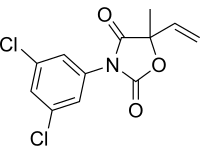
| |
| Names | |
|---|---|
| IUPAC name
(RS)-3-(3,5-Dichlorophenyl)-5-methyl-5-vinyloxazolidine-2,4-dione
| |
| Other names
Vinclozoline
| |
| Identifiers | |
3D model (JSmol)
|
|
| ChEBI | |
| ChEMBL | |
| ChemSpider | |
| ECHA InfoCard | 100.051.437 |
| KEGG | |
PubChem CID
|
|
| UNII | |
CompTox Dashboard (EPA)
|
|
| |
| |
| Properties | |
| C12H9Cl2NO3 | |
| Molar mass | 286.11 g·mol−1 |
Except where otherwise noted, data are given for materials in their standard state (at 25 °C [77 °F], 100 kPa).
| |
Vinclozolin (trade names Ronilan, Curalan, Vorlan, Touche) is a common dicarboximide fungicide used to control diseases, such as blights, rots and molds in vineyards, and on fruits and vegetables such as raspberries, lettuce, kiwi, snap beans, and onions. It is also used on turf on golf courses.[1] Two common fungi that vinclozolin is used to protect crops against are Botrytis cinerea and Sclerotinia sclerotiorum.[2] First registered in 1981, vinclozolin is widely used but its overall application has declined. As a pesticide, vinclozolin is regulated by the United States Environmental Protection Agency (U.S. EPA). In addition to these restrictions within the United States, as of 2006 the use of this pesticide was banned in several countries, including Denmark, Finland, Norway, and Sweden.[3] It has gone through a series of tests and regulations in order to evaluate the risks and hazards to the environment and animals. Among the research, a main finding is that vinclozolin has been shown to be an endocrine disruptor with antiandrogenic effects.[citation needed]
- ^ Cite error: The named reference
EPA R.E.D Factswas invoked but never defined (see the help page). - ^ "Vinclozolin" (PDF). Santa Cruz Biotechnology, Inc. Retrieved 31 October 2011.
- ^ Boyd, David R. (October 2006). The Food We Eat: An International Comparison of Pesticide Regulations (PDF). Vancouver, BC, Canada: David Suzuki Foundation. p. 12. ISBN 0-9737599-9-2. Archived from the original (PDF) on 2015-07-14. Retrieved 9 February 2015.